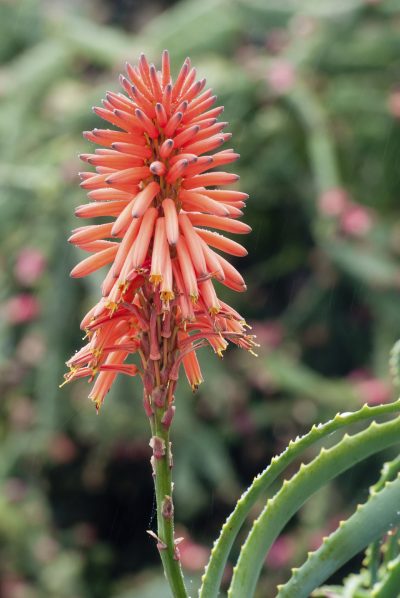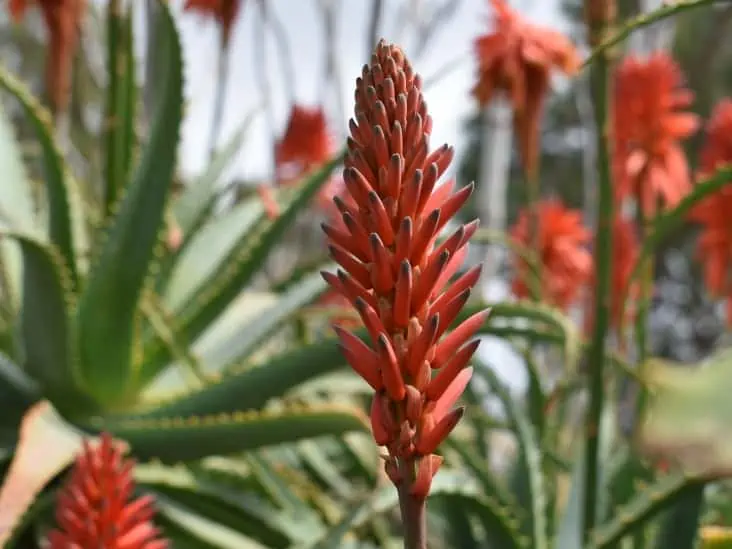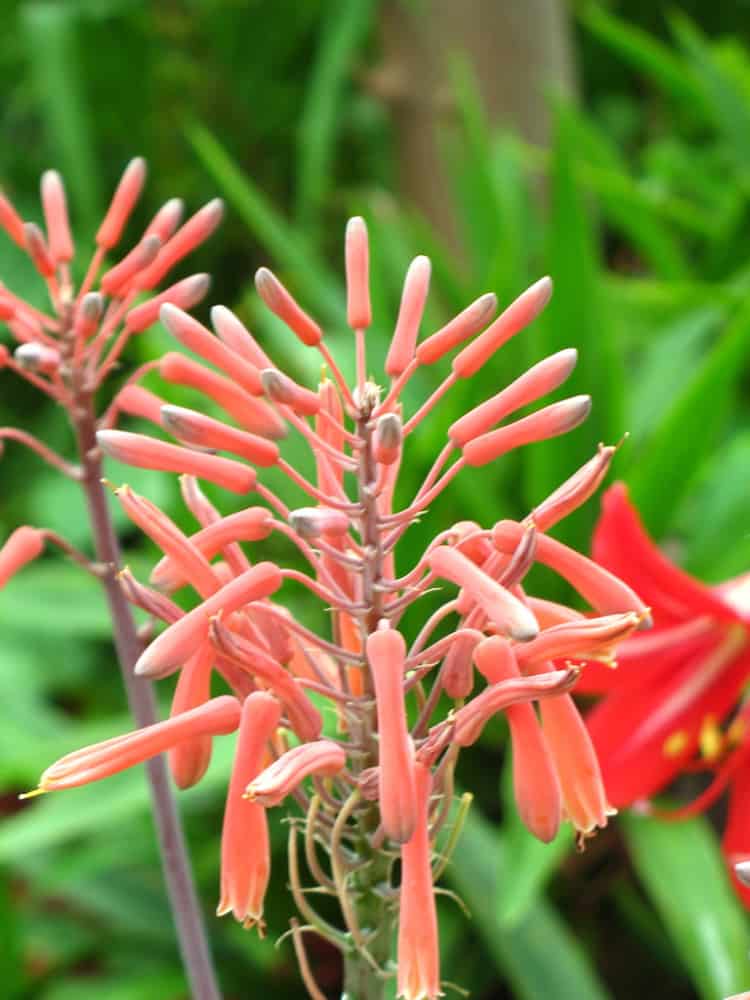If you’re wondering whether aloe vera blooms or not, if this succulent does in fact produce flowers, what kinds of flowers they have, when they bloom, and how to get my aloe vera plant to do so, you’re not alone. There are a lot of possible questions. I’m here to respond to all of your inquiries.
Aloe vera can flower if it receives warm temperatures, the right nutrients in the potting soil mix, attention, timely watering, and the aging factor. These plants bloom as they age, and although some of their leaves may fall off as they age, there are occasions when aloe vera flower stalks may bloom. Even though it still only blooms once a year, we can still try our best. Aloe vera flower stalks should be trimmed from the bottom if they die since they may contain all the nutrients necessary for the growth of future aloe vera stalks and leaves.
Aloe vera provides medicinal benefits in addition to creating unusual flowers that most people are unaware may blossom. Aloe blooming can be uncommon, although it is feasible in heated or warm climatic regions where it receives the ideal conditions for growth.
Table of Contents
What do you do with an aloe plant after flowering?
Cut the flower stalks off an aloe plant once the flowering is finished and the plant begins to dry out because the flowers won’t reappear and will just continue to absorb nutrients from the soil. Your aloe plant won’t be harmed by this, and it might even grow extra leaves as a result.
Additionally, some of the aloe plant leaves that are growing outside may start to dry out or die. This is because they have grown older and it is typical for them to turn brown. Pruning those aloe leaves will therefore help your succulent plant stay healthy and happy.
Additionally, I advise removing any dark aloe plant leaves because they don’t look nice and attract pests like mites and mealy bugs. Aloe vera will undoubtedly become taller if it receives enough light each day. Avoid overwatering them over the winter months and let them to grow naturally. If the soil is dry, only water it. In the summer, it’s the exact reverse; you need to give them water and put them in a spot with plenty of sunlight.
Does Aloe Vera die after flowering?
The Short Answer: Aloe vera will continue to grow after flowering, just like other tropical, semi-flowering plants do. Because it only blooms for 3–4 months after the aloe vera plant first blooms in early spring and because its limited bloom period ends in late summer, aloe vera flower blooms are susceptible to drying out and aging.
Even though they can withstand the intense sunshine in deserts, aloe plants are robust succulents that don’t frequently perish by blossoming. Aloe plants are ready to grow once the flower stalks are simply pruned in from the base. Aloe blooms often have a reddish-yellow color and stand upright on a strong, sturdy flower stalk, which is also known as a flower stem.
The aloe plant won’t be harmed by the blossoming, but if you wait too long to prune the flower stalks, the aloe plant will continue to collect all the nutrients from the ground. Additionally, if you don’t want to clip the flower stalks, just leave them alone; they will naturally dry out and wither away, but your aloe plant will carry on growing the way it was before it started flowering.
How often do aloe vera plants bloom?
Aloe vera plants only bloom once a year, and while you may notice the flower stalks beginning to form in the spring and blossom, most of us have the plant growing close to windows, televisions, laptops, or even in bedrooms or hallways, so we rarely see aloe vera bloom. In order to find out why it doesn’t blossom, I did some study and discovered that particular circumstances must be met.
Warm temperatures, nutrient-rich soil (which simply implies fertilizer application), mature aloe plants with large, thick leaves, plenty of sunlight—never assume it will bloom indoors—these are all beneficial circumstances for an environment. Outside, flies and flower stalks may engage in a process known as pollination that could result in flower blossoms.
However, the temperature and maturity of the plant are more crucial; aloe vera doesn’t even flower in small pots. Over the years, you will need to replace the pot numerous times, and once it has grown old and in all ecologically favorable locations, it will eventually bloom.
Aloe plant blooms do best in USDA Zones 9 to 12, where there is more heat and a warmer temperature than in the lower zones. Phosphorus-rich fertilizer can give aloe vera plants vibrant hues and possibly encourage the growth of flower stalks. I might upload a video to make sure you see aloe vera plants, often known as aloe plants, and their yellow to orange flower blossoms.
Purchase 15-30-15 fertilizer from Amazon by clicking here.
The ratio of nitrogen, phosphorus, and potassium is 15-30-15.
How long does an aloe vera flower last?
Aloe vera blossoms can endure until the end of the summer, but they are quite uncommon. Early spring saw the arrival of aloe plant stalks for many people, and some believe the plant may blossom later in the season. These reasons could be the reason why aloe plants bloom earlier in USDA zones like zone 12 and later in USDA zones 9 and 10.
Aloe plants only have one to two months of blooming every year, after which they dry out and die. Therefore, you should prune them because they will simply use soil nutrients. By cutting flower stalks from the base, you can assist your aloe vera recover from its already dried-out and browned leaves. As leaves deteriorate, fresher leaves replace them, indicating that the soil should be able to supply the plant with all the nutrients it needs. If the soil has reached this point, blooming fertilizers may be introduced, which could aid in the aloe vera’s bloom.
How do I get my aloe plant to flower?
When aloe plants receive full sunlight and warmer weather, they have the best chance of blooming. Aloe plants need fertilizer, soil that drains properly, and a lot of water to grow their flowers throughout the summer. Aloe plants that have been matured for 4-5 years, grown large, and developed thick leaves have a greater likelihood of producing flower blossoms.
The ideal growing conditions for these aloe blossoms are in zones 9, 10, and 11, where the heat favors early flowering. Additionally crucial are caring and watering. Aloe is typically grown for both its cosmetic and medicinal properties; as a result, it is simple to cultivate and needs little attention.
Aloe plants need temperatures exceeding 61 degrees F (16 degrees C) and timely watering to ensure that they bloom the following year, therefore bringing them indoors will not promote flowering.
Use a phosphorus-rich fertilizer, which is ideal for flowering in indoor and outdoor plants, to promote growth and you might soon see the aloe vera plant’s flowers bloom. The fertilizer can be purchased using the link in the above section.
Aloe is more likely to blossom in a warm environment or in an adequate amount of direct sunlight when the pot is larger and it has matured and grown for many years. Yes, it might harm the leaves and cause them to turn brown, which is why some people move the aloe vera indoors after it has had enough sunshine for 3-5 hours.
Because aloe leaves shouldn’t become sunburned, you should put them outside in the morning sunlight from 9 to 11 a.m., and then bring them back about 11 or 12 a.m. Make sure to check the aloe plant everyday for signs that it could need extra water and avoid blunders like unnecessarily overwatering it. Before adding more water, always make sure the soil is not too dry.
One thing I observed is how much the blossoms resemble red hot poker plants. Check out my post and decide for yourself.
What does the flower of an aloe plant look like?
Birds, bees, and flies are drawn to these blossoms, aiding in pollination of the plant’s flower stalks so that our aloe plant can bloom later. Typically, birds will rest and even sip nectar from the plant while perched on these flower stalks.
Aloe vera has leaves that are spiky, thick, aqueous filled, and greenish in color. These leaves store water, allowing the plant to withstand dry days even in the absence of water. These aloe plants can adapt to a variety of environmental situations because they can be found in desert regions.
In zones 10–12, aloe flowers can bloom early because they can develop more quickly in warmer climates. It is quite unlikely that you will ever attempt to cultivate them during the winter months because these plants detest damp weather, and we all know that aloe thrives in warm climates rather than bitterly cold ones.
Do aloe vera flowers have a scent?
Flowers from aloe vera have no smell, and birds and bees visit them for resting or pollination. The entire flower is fashioned like a sphere thanks to these orange clusters that resemble tubular pipes. Don’t be concerned about the aroma of aloe flowers because it is neither offensive nor unpleasant. You could note that the gel inside of its green spiky leaves has an unpleasant smell, similar to that of rotten potatoes, garlic, or onions. Aloe vera plants can have a decaying smell, but their gel has tremendous healing capabilities and is better for our skin, which is why it is so well-liked by women in particular.
Aloe vera gel is clear, sticky, and stiffened. It is not smooth. Aloe plant juice scarcely separated even in hot, boiling water.
Do all aloe vera plants bloom?
No, not all aloe vera blossoms. Many individuals have expressed disappointment that their aloe plants, despite being grown for many years, are not blooming. There are many aloe plant varieties that rarely bloom, and it is uncommon for these plants to claim that they can bloom only once a year. In truth, blooming can only take place if the aloe plant appreciates the atmosphere and the nutrients in the soil. Yes, they do prefer a better climate. For example, they are more likely to bloom in USDA zones 10 and 12 if it is warmer there.
The location of this plant is vital, but so is how you have it set up because aloe vera needs the greatest sunlight and nutrient-rich soil to flower.
Aloe will undoubtedly produce tubular-shaped blossoms when given the necessary circumstances and care, which works like magic. Only elder aloe plants may produce these blooms; younger plants lack the energy necessary to produce fresh flowers. Aloe vera plants may begin to bloom in the early spring and continue to do so through the summer.
Apply liquid fertilizer to your aloe plant in the summer as this is the optimal time to fertilize most flowering & semi-flowering plants, including aloe vera.
These flowers can range in hue from orange to yellow, and you might find another color with a different kind that resembles our aloe plant.
Is Aloe Vera flower lucky?
Although aloe vera plants as a whole have wonderful healing powers that help treat burns, wounds, and skin conditions like rosacea, aloe vera flowers don’t have any special meaning or associations with luck.
According to Healthline, it can help prevent dry skin and contains anti-inflammatory properties that aid in wound healing. Even acne is supposed to respond well to it.
Important Information: If you can reduce your sugar intake, aging can be delayed.
As they are feng shui plants, there are some plants that can offer luck and more pure air.
- Money Tree
- prickly plants
- Jade Trees
- Blessed bamboo
- Palms
- Orchids
- with a ton more.
Some plants are considered lucky because they have the potential to purify the air and have advantages that can be beneficial in today’s world. Others are able to eliminate unhealthy air from the indoor environment.
If you’re starting a new gardening space with a variety of plants that are different from one another, the plants on the list above are the greatest companion plants for our aloe vera plant. The majority of the plants we cultivate indoors are healthy, natural, simple to care for, eliminate toxins from the air, and much more.
Can you eat aloe vera flowers?
Aloe vera flowers cannot be consumed by either people or animals because there is no reliable source that can attest to this. Typically, when people search, they utilize aloe vera leaves, which, according to healthline, are delicious and safe to consume. The gel is also used in skin healing.
According to Healthline and Webmd, Aloe vera gel from the plant’s leaves can even be used with warm water to treat gastrointestinal issues like constipation. It also possesses antioxidants that can help prevent diseases like cancer.
In essence, these nutrients are packed in aloe vera leaves since it also contains vitamins that are crucial to our bodies, such as vitamin C, B, E, and folic acid.
However, there is still a problem if aloe water is used frequently because it may cause difficulties with the kidneys, the heart, the stomach, and other organs. Don’t consume too much of it, then.



